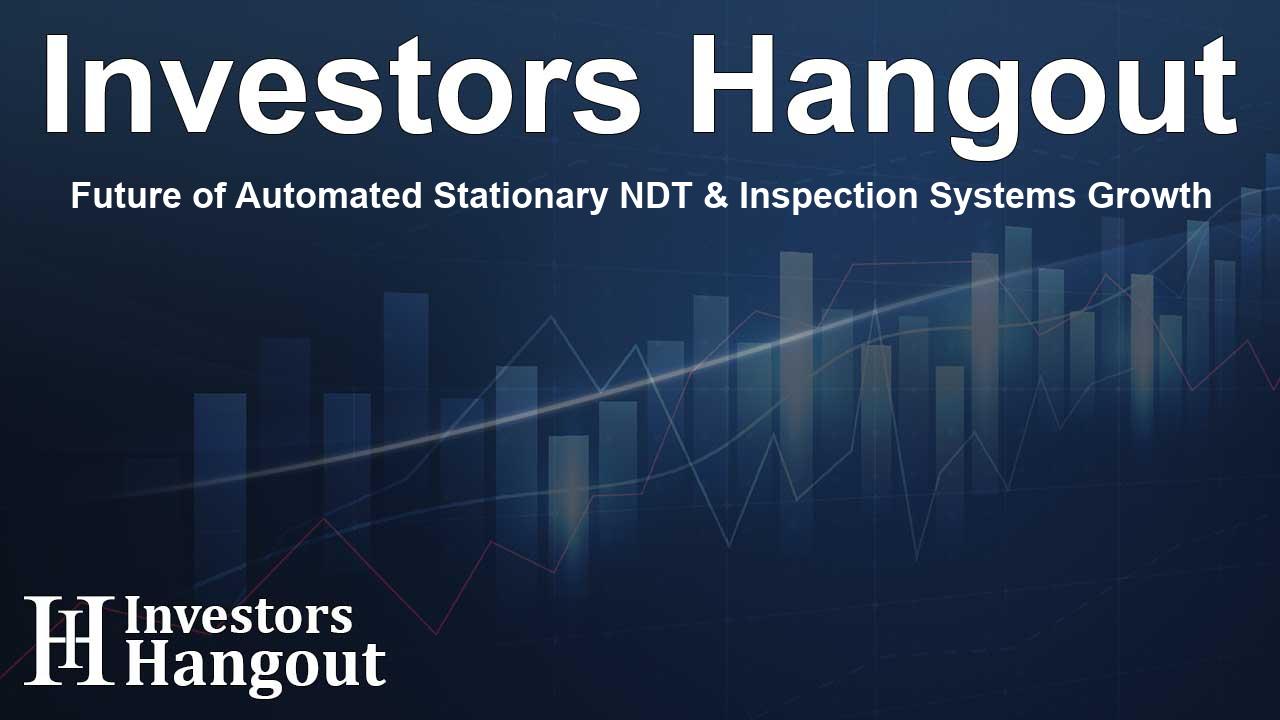Future of Automated Stationary NDT & Inspection Systems Growth

Overview of the Automated Stationary NDT & Inspection Systems Market
The global automated stationary NDT (Non-Destructive Testing) and inspection systems market is seeing promising growth, expected to increase significantly by the year 2030. This evolution towards a projected market value of USD 1,195.9 million highlights a remarkable CAGR of 9.3%. The demand stems from the necessity for precise and efficient inspection solutions across various sectors, including metals, automotive, and aerospace. These automated systems are designed to facilitate real-time defect detection, thus minimizing dependence on manual inspection methods and enhancing operational efficiency.
Key Growth Drivers and Market Trends
One of the major drivers of this burgeoning market is the regulatory pressure for compliance concerning safety and quality standards, which has led to increased adoption of advanced inspection technologies. Furthermore, technological advancements in Artificial Intelligence (AI), machine vision, and the amalgamation of different technologies are reinforcing system capabilities, making them more appealing to industries reliant on inspection systems.
Market Revenue and Forecasts
According to recent studies, the automated stationary NDT and inspection systems market is projected to attain a revenue of USD 767.4 million in the near future. By 2030, this number is set to escalate significantly, portraying a lucrative forecast period from 2025 to 2030. This growth reflects the rising trend of implementing technologically advanced solutions to enhance production quality.
Market Segmentation and Insights
Within the automated stationary NDT and inspection systems market, various segments are gaining traction. Among these, ultrasonic testing technology is forecasted to hold the largest market share, renowned for its high accuracy in detecting flaws within materials across numerous industries. Its implementation is vital for quality control processes, especially in environments with high production volumes.
Rapid Growth of In-line Inspection Systems
The in-line system type is noted to be the fastest-growing segment of the market. This surge can be attributed to the increasing requirement for real-time quality assurance during production processes. As these in-line systems integrate seamlessly into existing workflows, they provide continuous monitoring while substantially decreasing inspection durations. This advantage is particularly attractive for sectors like metals and automotive, where safety regulations are strict, and operational efficiency is paramount.
Regional Market Insights
Regions like Europe are anticipated to experience significant growth in the automated stationary NDT market due to their firm commitment to industrial automation and the enforced quality standards across various sectors. Strategic government initiatives that encourage digital transformation and infrastructure renewal further accelerate the adoption of these automated systems. Countries with established NDT technology providers will likely continue to command a notable share of the market.
Competitive Landscape
Leading players in the automated stationary NDT and inspection systems market include notable companies operating globally. Firms such as EVIDENT, Waygate Technologies, FOERSTER, Eddyfi, and Magnetic Analysis Corporation are key participants driving innovation and enhancing market competitiveness through technology advancements and customer-driven solutions.
Conclusion and Future Directions
The automated stationary NDT and inspection systems market is positioned for substantial growth as industries continue to embrace innovative technologies. Companies are working actively to improve inspection processes, ensuring higher standards for quality and safety. As the market evolves, collaborations and advancements in technology will be essential in meeting future demands and maintaining a competitive edge.
Frequently Asked Questions
What does NDT stand for in this context?
NDT stands for Non-Destructive Testing, a method of testing materials for defects without causing damage.
What are the key technologies used in automated inspection systems?
Key technologies include Ultrasonic Testing (UT), Eddy Current Testing (ECT), machine vision, and AI integration.
Which sectors are most affected by the growth of this market?
Sectors such as metals, automotive, aerospace, and manufacturing are significantly impacted as they increasingly adopt automated inspection solutions.
What is the expected market value by 2030?
The market is projected to reach approximately USD 1,195.9 million by 2030, indicating a robust growth trajectory.
Are there any challenges facing the market?
Yes, challenges include the limited availability of skilled integration experts and proven use cases in the field, which can hinder adoption.
About The Author
Contact Thomas Cooper privately here. Or send an email with ATTN: Thomas Cooper as the subject to contact@investorshangout.com.
About Investors Hangout
Investors Hangout is a leading online stock forum for financial discussion and learning, offering a wide range of free tools and resources. It draws in traders of all levels, who exchange market knowledge, investigate trading tactics, and keep an eye on industry developments in real time. Featuring financial articles, stock message boards, quotes, charts, company profiles, and live news updates. Through cooperative learning and a wealth of informational resources, it helps users from novices creating their first portfolios to experts honing their techniques. Join Investors Hangout today: https://investorshangout.com/
The content of this article is based on factual, publicly available information and does not represent legal, financial, or investment advice. Investors Hangout does not offer financial advice, and the author is not a licensed financial advisor. Consult a qualified advisor before making any financial or investment decisions based on this article. This article should not be considered advice to purchase, sell, or hold any securities or other investments. If any of the material provided here is inaccurate, please contact us for corrections.
